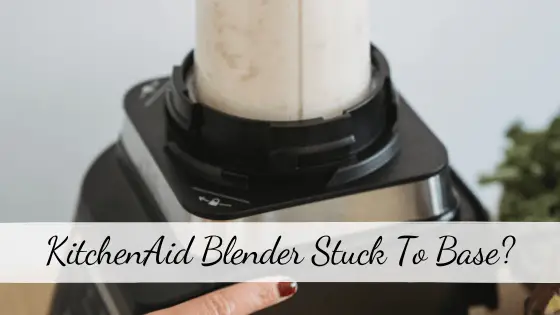Like any other electrical appliance, a blender will often display mechanical errors.
It’s somewhat concerning how so many people struggle with menial blender problems.
Are you dealing with a case of KitchenAid blender stuck to the base?
Then you should know that you are not alone.
Blenders tend to get stuck at the base quite often for a number of reasons.
You don’t have to rush it to your local mechanic just yet.
Before anything, it is essential to diagnose the problem and understand if you can do to solve it yourself.
Causes of KitchenAid Blender Getting Stuck to Base
A blender can get stuck to its base when the components are dirty and/or assembled damp or wet.
The motor will last more if you naturally put less strain on it.
Cavitation is a problem with all blenders, not just the ones from KitchenAid.
This is caused by an air bubble getting stuck over the blender assembly.
The blender blade might also get stuck after you use the blender to make creamy dishes like nut butter or hummus or when you blend round foods like apples.
Most blender blades are made tough as they have to shred chunky objects.
The blades have to be lubricated regularly to make sure they spin smoothly and unjam any stuck blades.
If the blades aren’t moving after you went wild with party drinks, chances are, the blade assembly is saturated with sticky liquids or syrupy goo.
Moreover, the sticky situation may have also been caused by an incorrectly assembled blender.
Follow your owner’s manual to assemble the blender bits properly.
6 Fixes to Unjam KitchenAid Blender Stuck to Base
Method 1
Step 1. Remove the plug from the socket
You shouldn’t risk activating the blender while the bottom is stuck, so we strongly recommend you unplug the blender completely and only place it back once you are done.
Step 2. Flip the unit
Although this step might sound odd, this is an important part of the process. Simply flip the whole cup, placing it upside down.
Step 3. Tap the bottom gently
Tap the cup’s bottom gently on the kitchen counter 5 to 6 times with the whole machine upside down.
This should loosen up any remaining debris or components resisting the extraction of the cup.
Step 4. Turn the cup anticlockwise
Once step 3 is done, instantly turn the cup anticlockwise. Be gentle with it.
This should separate the blender cup from the blender base.
If one side of the blender cup is attached under the actuator, an alternative step can be used to pry it away.
Take a small flat screwdriver and with its tip, turn it around the blender cup to make sure the cup’s lip is fully positioned over the actuator.
Now, simply position the screwdriver next to the actuator and lift the lip up from the actuator, pulling away from the cup.
At this point, the cup should be released, and you can get to cleaning the KitchenAid blender before reassembling.
Method 2
This method is easy and quite effective.
First, pour warm (not steeping hot) water into the pitcher and wait 10 minutes. Then, jiggle the cup back and forth with two hands at the top and try to lift it off. The heat should loosen up the stuck bits.
Method 3
Apply a little cooking oil to the exterior of the glass and let it run down into the threads of the base.
Next, drop a little diluted dishwasher liquid inside the blender and place it back on the power unit.
Turn the blender on for a few seconds to activate the dishwashing liquid.
Let it sit in that position for a few hours, and you should be able to take out the glass from the bottom at this point.
When dry, the starch concentrated on the dirty surface acts as glue.
The bond is loosened when the component is rehydrated, and you should be able to unscrew the base without problems.
Method 4
Rubber strap wrenches are useful but mostly as a sort of last resort.
So if nothing else works and you don’t mind risking the damage of your KitchenAid blender, go ahead.
Rubber strap wrenches are available in a set of two – a large one and a small one. Before using one, make sure all the surfaces are oil-free and dry.
To start, place the base and jug into the dishwasher and put it through a whole wash-dry cycle.
After drying it, try removing the base while the unit is still warm.
Next, soak the whole assembly in warm water – repeat till the water cools off.
Finally, try again with the strap wrench once dry.
Check out the Craftsman 2-Piece 16” Rubber Strap Wrench Set.
Method 5
A bit more technique is required for method 5.
First, you need to unscrew and dismantle the blade.
For that, take two rags and, using one of them, grab the blades carefully (do not cut yourself).
Next, rotate the rubber piece on the exterior anticlockwise – the opposite of what you should do to loosen it.
At this point, check for corrosion on the blades.
If any, spray it down with some WD-40 and smoothen out any corrosion.
Next, add a little bit of grease, wash down the other parts and dry fully.
Wait for a few hours before reassembling.
Method 6
Method 6 should not be attempted by anyone with no prior experience handling electronics such as blenders or grinders.
This process will have you tampering with electric wires, and if you aren’t up to the task, better task your kitchen tool to a professional.
1.Unplug the unit from the socket (can’t have you getting electrocuted).
2. Take out the four screws on the base, the motor shield, and the cover plate.
3. Take out the white motor from the binding clip.
4. There should be a plastic sleeve equipped with a fusible link. Locate that.
5. Detach the sleeve and inspect for continuity between the points on both sides. You would need an ohmmeter for this.
6. If no continuity is detected, clip out the fusible link before soldering the white wire together again.
7. Cover with a strip of tape.
8. Reattach to other wires.
9. Change the bottom and check.
Why Is My KitchenAid Blender Button Stuck?
The main reason behind the blender getting stuck is trapped big air bubbles.
You can prevent it by filling the blender pitcher with a good balance between the ice and also the liquid you intend to combine with the ice or any other frozen food you might have in mind.
Most good blenders also come with pulse features, which can come in handy in such situations.
Fix Your KitchenAid Blender Button Stuck
If your Kitchenaid blender buttons get stuck with no power or blinking lights, you can fix it easily.
For this, you need to take it apart the blender and fix it. It is very much easy and I know it surely work for you!
You don’t need any fancy tools and soldering needed, you just need a simple a Phillips head screwdriver!
Following is the step-by-step guide for you to solve this issue!
Disconnect appliance from the power source
The first thing you need to do for this is unplugging the blender from the socket.
It will avoid any electrical hazards.
Don’t just try to switch off the power from the outlet, unplug it entirely.
Remove the footpad of your Kitchenaid blender
Kitchenaid blenders have their screws hidden underneath the footpads, and the only way to access them is by removing those footpads.
Take the bottom of the blender apart by removing the rubber foot pads and removing the exposed 4 screws.
Remove the panel clips
Remove the 3 sets of wires attached to the inside panel of the blender with clips.
It is very easy to remove by squeezing at the base of the clips and pulling up.
Make sure you are not squeezing too tightly, as only a little amount of force you will need to get the job done.
Detach the screws from the panel
After unclipping the panel, you are exposed to the panel.
You need to remove this panel before you take further steps.
Remove the 2 screws which are holding that panel in its place and lift them off.
Remove the second panel under the top panel
After removing the first panel, you can see another panel fixed with two screws.
Now, remove the panel under the top panel by loosening and removing 2 screws.
When you flip this panel over you can see what operates the switches.
In some Kitchenaid blenders, the black plastic nubs push against the buttons that get stuck and get twisted off-kilter which results in resetting properly.
Insert a small screwdriver in there to try and straighten them as much as you can.
All of these steps are the same as you disassemble your Kitchenaid blender.
Put everything back together
Ensure that the button can now be pressed without it getting stuck before assembling the parts you dismantled, and make sure it is done with uttermost precision.
Push on the backside of the buttons that get stuck to get them unstuck before putting everything back together.
Screw back the panels as the way you removed them.
Then clip back the wires by pressing the clips gently and placing them in the connector spots on your Kitchenaid blender.
After completion of these steps, your blender is back again to use!
Final Thoughts
Whenever you are dealing with an issue regarding your electronics, the best approach is to diagnose the problem first.
You might find that a DIY project can resolve the issue.
If your Kitchenaid blender is getting stuck to the base, it is really easy to fi at home.
If not, you can always take it to a professional later on.
References:
https://www.fixya.com/support/t21236637-blender_base_stuck_budge
Related Articles:
KitchenAid Blender Flashing Lights?
KitchenAid Blender Coupling Melted?
KitchenAid Blender Smells Like Burning?


